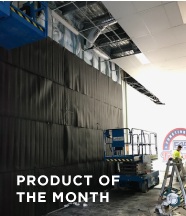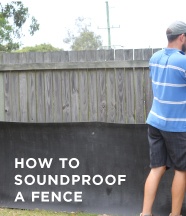If your home is now your workplace too, this can be both exciting and also worrisome. It’s exciting because you no longer need to take a shower and can simply work in your PJs. However, it’s worrisome because there are distractions everywhere. Your child may want to play with you, your partner may want to sweet-talk you, and your upstairs neighbour might decide that this is the best time to take YouTube tutorials for tap-dancing.
How do I stay focused?
Change starts with you. Having said this, we know that even having a dedicated workspace and avoiding procrastination cannot help you if your surroundings do not cooperate.
So what do you do? Yep, you guessed it — you change the surroundings.
No, we don’t mean rearranging the furniture or kicking your child out of the house. We mean soundproofing the home office. (The title gave it away, didn’t it?)
How do I soundproof my workspace fast?
“Haste is of the Devil”.
We’re kidding, don’t beat yourself over it. In this fast-paced life, nobody has time to waste. This is why we are offering multiple options. Depending on how much time you have and how much noise you’d like to reduce, user discretion is advised. Be mindful of the fact that the bigger the air-gap, the more the noise.
We will try to eliminate as much noise and get rid of as many air-gaps as we can.
Option 1—Acoustic Windows
Acoustic windows are the most effective way to block noise at the source. By installing a second layer of glass over your existing window, each pane works as an independent barrier. The larger the gap, the more noise reduction you’ll enjoy. This solution is ideal for home offices because it not only cuts down outside distractions but also reduces heat transfer, helping keep your room comfortable all year round.
Benefits:
- Blocks up to 70% of outside noise
- Quick installation with no need to replace your existing window
- Improves energy efficiency and reduces power bills
- Works for traffic noise, neighbours, or street sounds
Option 2—Use sound absorbers on walls/ceilings
You can use absorption panels and affix them directly on your walls. These need to cover the wall that you share with the noise-source (perhaps the apartment next door). All gaps between panels should be sealed with an acoustic sealant.
The Fibertex may not be too visually appealing, but you can always wrap it in fabric for aesthetic purposes. Another option is using Stratocell® Whisper™, which is a moisture-resistant sound absorption foam. This is a costlier option but some might prefer it.
If you don’t want to change the simplicity of the wall, you can also put sound absorption material inside your walls. Mineral wool or Fibertex are both good candidates for this task. You will need to remove the existing plasterboard, and then insert the absorption material at the back of the noise-source room’s plasterboard.
Once done, proceed to reinstall the plasterboard following the standard installation procedures for plasterboard.
Soundproofing inside the wall is always trickier and is more time-consuming. However, we can assure you (that if done well), you will have zero regrets about your decision.
Option 3—Use sound barriers on the walls/ceilings
Sound barriers, unlike absorbers, block the direct path of soundwaves. This works well for enclosed spaces like rooms because you can cover the entire wall with a sound barrier. At Soundproof Warehouse, we recommend sound barrier sheets like Sound-Stop 5 for this purpose.
You can affix the Sound Stop 5 directly on the wall using Mechanical fixings. You can also layer the sound barrier between the plasterboard and sound absorption material inside the wall or ceiling.
Super grip tape and sealant are intended exclusively for sealing purposes. Secure the Sound Stop 5 using mechanical fixings, consult the installation guide for detailed instructions.
Option 4—Seal all holes
We might have mentioned the importance of sealing holes before but this deserves a special mention of its own. Air gaps will let sound through, so ensure that you seal any teeny-tiny holes using an acoustic sealant.
What kind of holes, do you ask? These could include cable holes, recessed lighting holes (ceiling), termite exit holes, or simply drilled holes.
Choosing the Right Noise Reduction Solution
| Solution | Noise Reduction | Cost | Installation Time | Best For |
| Acoustic Windows (Secondary Glazing) | ★★★★★ | Medium | 1–2 hrs | Offices, bedrooms |
| Absorber Panels | ★★☆☆☆ | Low | DIY | Shared walls |
| Sound Barriers | ★★★☆☆ | Medium | Renovation | Large spaces |
| Sealing Gaps | ★☆☆☆☆ | Low | Quick fix | Minor noise |
Recommended Solution: Acoustic Windows
The fastest and most effective way to reduce noise is by installing acoustic windows (secondary glazing). Call us today to discuss your options.
Don’t fall for these ‘hacks’
Here is a small list of ‘fixes’ that you are better off staying away from. Soundproofing hacks more often than not, do not work.
- Egg cartons – Egg cartons are not made for acoustic solutions. Leave them in the recycling bin.
- Soundproof Paint – This might work if you are trying to avoid very low-frequency sounds. If your baby is crying next-door, not so much.
- Soundproof Curtains – These will help control some reverberation but will not isolate the noise.
- Rugs and Carpets – These are adequate for reducing echoes in your room. They will, however, not avoid noise coming in from your downstairs neighbour.
We hope that this article was helpful for you if you’ve been having a hard time concentrating due to distracting sounds. If your annoyance towards certain sounds is extreme, you may want to consider a test for Misophonia.
It is a trying time for us all, but we hope that with a little soundproofing help, you will be able to work to your full potential. For tips, suggestions, and product enquiries, feel free to call Steve on 07 3287 7647.


















